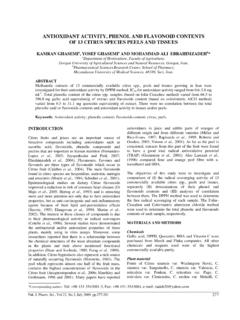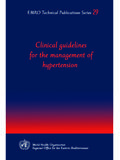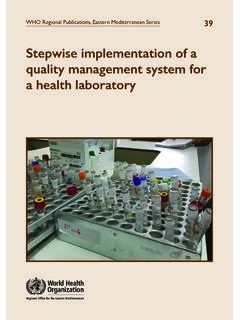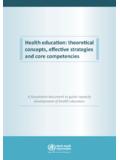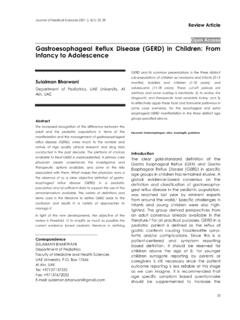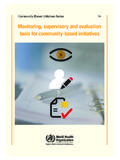Transcription of A Systems Thinking approach for responding to the COVID …
1 872 CommentaryEMHJ Vol. 26 No. 8 2020A Systems Thinking approach for responding to the COVID -19 pandemic Imad Hassan,1 Fatima Obaid,1 Roa Ahmed,1 Lobna Abdelrahman,1 Sara Adam,1 Omiema Adam,1 Mohammed Alfatih Yousif,1 Khobieb Mohammed1 and Tayseer Kashif11Al Tababa Knowledge Translation Unit, Al Tababa Advanced Training Center, Khartoum, Sudan. (Correspondence to: Imad Hassan: Hassan I; Obaid F; Ahmed R; Abdelrahman L; Adam S; Adam O; et al. A Systems Thinking approach for responding to the COVID -19 pandemic. East Mediterr Health J. 2020;26(8):872 876. : 07/05/20; accepted: 06/07/20 Copyright World Health Organization (WHO) 2020.)
2 Open Access. Some rights reserved. This work is available under the CC BY-NC-SA IGO license ( )IntroductionThe human, social and economic costs of the COVID -19 pandemic are enormous. It is paramount that effec-tive control strategies are implemented especially in resource-poor countries to initially mitigate and finally control this novel infection. Systems Thinking is con-sidered a paradigm shift in human Thinking . It first ap-peared in the business and management arena but has spread to all disciplines or Systems , especially when the human factor is a pivotal element, , in social Systems .
3 It was first publicized by a Nobel prize winner, Professor Peter Senge in his book, The Fifth Discipline (1). The World Health Organization (WHO) has in a recent landmark publication, as well as among some international experts, strongly advocated the employment of a Systems Thinking approach in formulating plans for resolving complex social and health issues (2); this includes the fight against COVID -19 (3). Systems Thinking is an indispensable tool for quality improvement (4) and has shown promise in the fight against Human Immunodeficiency Virus infection and Hepatitis C (5).
4 Understanding the conceptA system is defined as an entity with interrelated and in-terdependent parts that are working together to achieve a common purpose; health care is considered a system . At its core is the concept of components interdependence at multiple levels. Any change in one part of the system af-fects the part and the whole system . Areas where system interventions produce higher impacts (using an equiva-lent input), are termed strong- leverage points . The COVID -19 pandemic has so vividly brought this Systems interconnectedness to the forefront of human Thinking .
5 As a health-care issue, the COVID -19 pandemic resulted in unprecedented impacts on all domains of life economy, entertainment, transport, education etc. Additionally, it highlighted another critical domain in the Systems Thinking mindset the domain of unintended consequences . The latter will inevitably materialize as side-effects to any intervention used to control the pandemic. Examples are the negative impacts of social distancing, curfew, market closures, etc. on people s livelihoods, mental health, domestic violence and other non- COVID -19 medical ailments (6 9).
6 How to practice Systems Thinking ? Systems Thinking is a holistic approach to better under-standing of how the system elements interact with each other over time, the root-causes of system defects, and the right approach for a highly effective problem-solving intervention (strong leverage areas). Systems Thinking facilitates an in-depth understanding of system dynam-ics. Its tools enable its users to re-design their Systems , thereby radically creating the results they truly desire thanks to a methodology for identifying the root caus-es and critically selecting and focusing on the right strong- leverage areas.
7 There are 5 pivotal steps in Sys-tems Thinking : 1) root cause analysis, 2) selection of and focusing on strong- leverage areas, 3) system design or redesign coupled with 4) measures to nullify the impact of any unintended consequences resulting from these interventions and 5) continuous learning and improve-ment from the whole exercise. One simple tool for identifying and categorizing the root causes, thus pinpointing the leverage areas, is the Iceberg Tool (10). The latter stratifies the issue or problem under consideration and its root causes into 4 elements: 1) the event (the problem); 2) the underlying pattern (why it happened); 3) the structures directly responsible for the pattern; and 4) The underlying cultural and mental models that maintain these structures and facilitate the persistence of the problem.
8 Figure 1 portrays the Iceberg Tool and Figure 2 the Populated Tool for the problem of the COVID -19 pandemic in a resource-poor country. Systemic structures and mental models are considered the strong- leverage points that system leaders should focus on when dealing with complex social problems and conflicts. The significance and importance of focusing on interventions in the mental model domain were the motivators for a joint New York University and UNICEF initiative to design a course for a strategic global behavioural communication intervention to deal with infectious diseases epidemics (11).
9 Another Systems Thinking tool for depicting these strong- leverage areas, thus facilitating their incorporation as building-blocks for a highly effective system , is 873 CommentaryEMHJ Vol. 26 No. 8 2020the Biomatrix Tool, which emanated from Biomatrix Systems Theory (12). Its seven components constitute the building blocks for any effective system . They are the pillars for any transformational project, whether it is a population-based or government intervention, organizational intervention, hospital, department or clinical unit intervention or establishment, etc.
10 Unlike the classic description of a system with only its 3 basic components (structure, process and outcome), the Biomatrix tool smartly incorporates 4 extra indispensable elements for comprehensive and successful system design or redesign. Thus, one may utilize it to build a comprehensive anti- COVID -19 system for fighting the pandemic. Numerous interventions are recommended to prevent or slow the spread of COVID -19 infection (13 16). Table 1 depicts the seven elements, their definition and their relevant practical administrative components or actions for such a system .
